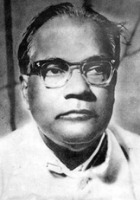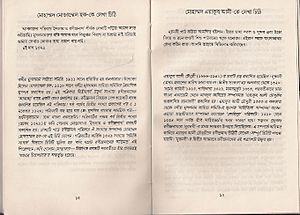Golam Mostofa (poet) facts for kids
Quick facts for kids
Golam Mostofa
|
|
|---|---|
| গোলাম মোস্তফা | |
 |
|
| Born | c. 1897 Monoharpur, Bengal Presidency, British India
|
| Died | 13 October 1964 (aged 66–67) |
| Nationality | Pakistani |
| Children | 7 (including Mustafa Monwar) |
| Parent(s) |
|
Golam Mostofa (Bengali: গোলাম মোস্তফা; 1897 – 13 October 1964) was a famous Bengali writer and poet. He wrote many poems, stories, and biographies. His works are still read and loved by many people today.
Contents
Early Life and School
Golam Mostofa was born in 1897. His village was Monoharpur, in what is now Jhenaidah District, Bangladesh. His family loved books and writing. They were good at Arabic, Persian, and Bengali languages. Both his father and grandfather were folk poets. This means they wrote poems that were popular with ordinary people.
Mostofa went to school in Damukdia and Fazilpur for his early education. He finished high school in 1913 from Shailkupa High School. Later, he earned his BA degree from Ripon College in 1918. He also got a teaching degree (BT) in 1922 from David Hare Training College.
His Career as a Teacher and Writer
Golam Mostofa started his career as a teacher in January 1920. He taught at Barrackpore Government High School. Over the years, he moved to different schools, including Calcutta Hare School and Calcutta Madrasa. He became the Deputy Head at Baliganj Government Demonstration High School. Eventually, he became the first Muslim headmaster of that school. He retired in 1949 from Faridpur Zila School.
In 1949, he became the secretary of the Language Reform Committee for the East Bengal Government. He believed in the two-nation theory, which was the idea behind creating Pakistan. During the Language Movement in 1952, he supported Urdu as the official language of Pakistan.
His writings were often inspired by Islamic history and culture. One of his most famous books is Biswanabi (1942). This book is a biography about the life of the Islamic prophet Muhammad. It helped him become widely known.
His Books and Poems

Golam Mostofa wrote his first poem, Adrianople Uddhar, when he was in tenth grade. It was published in a magazine called The Mohammadi. He continued writing for 48 years! He wrote many different types of works. These included poetry, biographies, novels, articles, and even translations of books from Arabic and Urdu.
Here are some of his well-known works:
Poetry Collections
- Roktorag (1924)
- Khoshroz (1929)
- Kabbo Kahini (1932)
- Sahara (1936)
- Hasnahena (1938)
- Bulbulistan (1949)
- Tarana-i-Pakistan (1956)
- Bani Adam (1958)
- Geeti Shonchalon (1968)
- Gulistan
- Prarthona
- Kishore
- Qobor
- He Khoda Doyamoy Rahmanur Rahim
- Badshah Tumi Deen O Duniyar, Nikhiler Chiro Shundor Srishti
- Amar Muhammad Rasul
Biographies
- Bishwanabi (1942) – A famous book about the life of Prophet Muhammad.
Novels
- Ruper Nesha
- Bhangabuk
- Ek Mon Ek Pran
Other Writings
- Islam O Communism (1946)
- Islame Jehad (1947)
- Amar Chintadhara (1952)
- Maru Dulal
Translations
- Musaddas-e-Hali (1941)
- Kalam-e-Iqbal (1957)
- Shikwa O Jowab-e-Shikwa (1960)
- Al Quran (1958)
- Joy Porajoy (Ikhwan As-Safa)
Awards and Family
Golam Mostofa received important awards for his contributions. These include the Sitara-i-Imtiaz and the President Medal.
He had four sons and three daughters. One of his sons, Mostafa Monwar, became a famous puppeteer. He was also a director general of Bangladesh Television. Golam Mostofa's youngest son, Mostafa Farooq, was the first pianist in Bangladesh. He studied music in London, England.
Golam Mostofa is also the grandfather of Syed Mainul Hossain. Syed Mainul Hossain was an architect who designed the Jatiyo Smriti Soudho. This is a national monument in Savar, Bangladesh. His great-grandson, Nafees Bin Zafar, is a software engineer. He even won an Academy Scientific and Technical Award!
His Legacy
Golam Mostofa passed away on October 13, 1964, at the age of 67. He died from a brain condition.
His ancestral home in Jhenaidah District faced some challenges in 2014. There were claims over parts of the land. Many items used by the poet and valuable drawings by his second son, Mostafa Aziz, were found in poor condition.
A concrete building for the Kabi Golam Mustafa Memorial Library was built in 2008. It is located in the yard of his house. However, there were not many reading materials inside. Some of his family property, like land and trees, were also reportedly sold.

